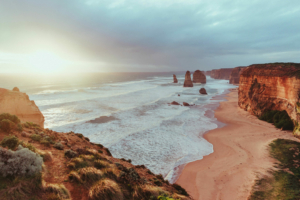Highlighting Australia
- As a proudly Australian initiative, we’re excited to showcase a collection of Australian stories, music, tributes and more.

Join activities, celebrations, study groups, spiritual empowerment and education programs for young people, and more.
Baha’i beliefs address essential spiritual themes for humanity’s collective and individual advancement. Learn more about these and more.

Featured in: The Bab and The Birth of the Bab
The Bab is the Herald of the Baha’i Faith. He was the bearer of a message destined to transform humanity’s spiritual life. His mission was to prepare the way for the coming of a second Messenger from God, greater than Himself, who would usher in an age of peace and justice.
Born in Shiraz, Iran on 20 October 1819, Siyyid Ali-Muhammad would become known to the world as the Bab (meaning “the Gate” in Arabic). The Bab was the symbolic gate; it was His mission to herald the coming of this promised Manifestation of God whom we know to be Baha’u’llah. In the Baha’i calendar, the Birth of the Bab and the Birth of Baha’u’llah are celebrated one after the other in one festival referred to as the “Twin Holy Days”.

I was speaking recently with a cute five-year old, and our conversation turned from the TV show Paw Patrol to the bicentenary of the Birth of the Bab. I asked him his thoughts on how we could celebrate the 200th anniversary of the Birth of the Bab, and he said: “We should make a nice card for His birthday and tell Him that He is the best Bab we have ever had!”
Aside from being amusing, from the perspective of the theology of the Islamic Dispensation, I thought he was kind of right; from what I’ve learned there actually have been several “babs”, or “gates” (in Shiite Islam it is believed that several historical figures called “gates” acted as intermediaries to the Promised One1). So, in this special year, how can we draw closer to the Bab who was the “King of the Messengers”,2 “the Primal Point round Whom the realities of all the Prophets circle in adoration”,3 the “Founder of the Dispensation marking the culmination of the six thousand year old Adamic Cycle, Inaugurator of the five thousand century Baha’i Cycle”,4 “The Primal Point from which have been generated all created things”?5
One place to start, perhaps, while conscious of our inherent limitations, “puny mortals that we are”,6 is to strive to develop a better understanding of His Station. To this end, I highly recommend a talk recently given by Mr. Hooper Dunbar at a major Baha’i conference in Malaysia (you can watch part one of the talk here, and part two here on Baha’i Blog). It really helped me gain an insight into the unique Station of the Bab. In addition, there is a beautiful musical piece released by Luke Slott that sets some of the Bab’s own Words about His Station to music (you can watch it here).
Then there are the dramatic events associated with what Shoghi Effendi described as “this most spectacular, this most tragic, this most eventful period of the first Baha’i century.”7 He explained that Nabil’s historical account, The Dawn-Breakers, should be an “unchallengeable textbook in Baha’i summer schools”, a “source of inspiration in all artistic and literary pursuits”, and an “invaluable companion in times of leisure.”8 He worked for over 10 hours a day for over 8 months translating it, writing at one point to Martha Root during this time: “I am so tired and exhausted I can hardly write.”9 But, he said, he engaged in this strenuous work because he felt “the same spirit that animated its early servants may again inspire the friends and arouse them to further exertions and sacrifices.”10 In another letter, he said:
Nabil’s narrative is not merely a narrative; it is a book of meditation. It does not only teach. It actually inspires and incites to action. It quickens and stimulates our dormant energies and makes us soar on a higher plane.11
What a year to become re-acquainted with The Dawn-Breakers, to have our dormant energies stimulated, and to soar on a higher plane! In the cluster where I live, about 40-50 people, ages 12 to 70+ recently had an amazing experience studying it together. The book is over 600 pages in length, so we met once a week over a six-week period, covering roughly 100 pages each meeting. Like any good Babi would, we divided up the 600+ pages into “vahids” of 19 pages each, and different people signed up to present the key events of those 19 pages. Or there were presentations on key topics, for example, someone who grew up in Saudi Arabia and was familiar with the Muslim pilgrimage to Mecca and Medina walked us through its key components so we could better understand when the Bab, Quddus and Mubarak went to Mecca and Medina. Another person had lived in Shiraz years ago and showed us video footage of all the key places in Shiraz associated with The Dawn-Breakers; it was almost like we went on a virtual “field trip” or even “pilgrimage”.
Once I became familiar with the key events from The Dawn-Breakers, my next quest was to better understand His amazing writings. For example, when Mulla Husayn gave Mirza Husayn Ali, later known to the world as Baha’u’llah, that beautiful scroll of Writings that was presumably from the Qayyumu’l-Asma, what did it say? When the Bab, unasked, revealed for Siyyid Yahya Darabi, later known as Vahid, a commentary on the exact Surih of the Quran he had fixed in his mind, what did that commentary say? While we don’t have complete translations yet in English of all these texts, we can get a general sense and outline by reading the incredible book, Gate of the Heart, by Dr. Nader Saeidi. I found it helpful in expanding my knowledge of the Bab’s Writings.
It is amazing to think that it is we who, during these swiftly passing years, are “the bearers of the name of God in this Day” and have the opportunity to exert our “utmost endeavor” that “in the world to come” He might “rejoice in (our) deeds and glory in (our) achievements.”12 It would be great to continue this discussion: please share in the comments section how this bicentennial year is impacting your personal and community study of the Revelation and helping you to “soar on a higher plane”!
"*" indicates required fields

We recognise their continuing connection to land, waters and community. We pay our respects to Aboriginal and Torres Strait Islander people and their cultures; and to elders both past and present.
The views expressed in our content reflect individual perspectives and do not represent authoritative views of the Baha’i Faith.

Visit the site of the
Australian Baha’i Community
and the Baha’i Faith Worldwide
Notifications
Your article on the Bab is an extraordinary summation of the celebration of the life that significant worldwide about this our Divine Prophet the Bab! Thank you so much for your story of the young five year old comments, that was fantastic as to what spin out of it!
Charles Wilson (May 5, 2019 at 4:28 PM)